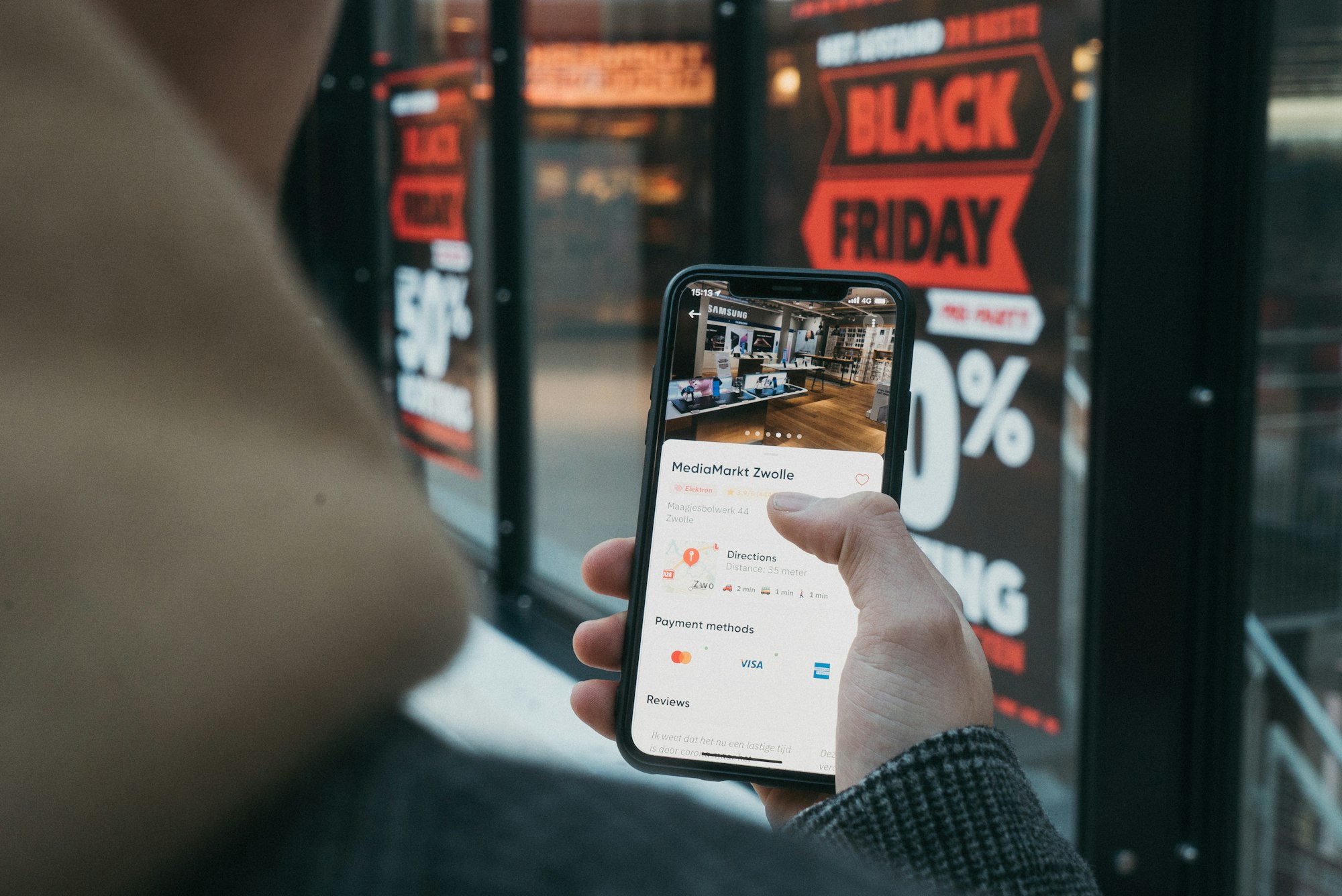What is Omnichannel Sales—And Why Is It The Future Of Commerce?
These days, everyone seems to be talking up the benefits of omnichannel sales. The buzz is hard to ignore—but what is omnichannel exactly? And what precisely is the difference between multichannel and omnichannel? Finally, does it make a difference?
These are the types of questions we're diving into today. In this blogpost, we're unravelling the mystery of omnichannel and will show its significance in the market. Because omnichannel isn't just a trend, it's the future of commerce.
Find out why more and more brands are making the shift to omnichannel—and why it's a solid investment that's sure to pay off big time for any company willing to take the plunge.

What Is Omnichannel Sales?
Omnichannel commerce isn't some fancy term—it's simply a smart way of selling goods to customers.
Omnichannel is all about making sure your customer gets the same awesome shopping experience from your company, whether they're using your store app, going to your website, phoning customer support, or strolling down the actual store aisle.
Harvard Business Review sheds light on a compelling statistic—a staggering 73% of customers engage with multiple channels during their purchasing journey.
Furthermore, the State of Commerce Experience reveals that almost half of all customers check out stuff online before making the trek to a real store. And get this—even when they're in the store, they're still peeking online for more info.
Which means that people are info-hungry. They gather information from diverse sources before deciding where to spend their hard-earned cash.
That's why being a savvy seller means looking at the big picture, not just how your shop looks on different screens. It's about nailing the whole shopping journey.
Think of it like giving your customers one heck of a smooth ride from checking out your goods online to grabbing them in person. The key is to concentrate on the holistic customer experience, ensuring consistency and satisfaction at every step of the journey.

The Difference Between Omnichannel and Multichannel
Okay, let's clear up the confusion between single-channel, multichannel, and omnichannel—which is key to shaping a successful retail strategy.
First off, single-channel is simply selling your goods in one place, be it your physical store, your online shop, or even an eBay listing. It works, but if you're aiming for that top-notch brand experience, you've got to think bigger.
Enter multichannel—selling your goods in various spots, online and offline. You're mingling with customers on social media, chatting on the phone, and rocking it in your real-world store. Multichannel is like opening more doors to your shop, making it a smart move for engaging your audience.
Now, here's where it gets interesting—omnichannel. It's like the upgraded version of multichannel. All those channels you're working on? Omnichannel bridges the gaps between channels, offering customers a fluid and integrated experience. Your customers get the best possible experience, even while hopping seamlessly from one platform to another.
In short, the commerce landscape spans from single-channel to multichannel and culminates in omnichannel. Single-channel focuses on one avenue, multichannel expands to multiple channels, and omnichannel takes it a step further by weaving a seamless tapestry of customer experience across all platforms.

The Benefits of Going the Omnichannel Route
Let's look at the difference ways that omnichannel commerce can give your business a boost:
Benefit #1: Supercharged Customer Experience
What's the golden ticket to winning customers over? A seamless experience that ties everything together.
Recent surveys have shown that 9 out of 10 consumers want the omnichannel experience— where every interaction they have with a brand flows seamlessly together.
As the number of touchpoints expands, the importance of flawless integration becomes evident. Whether it's a social ad, an email newsletter, a mobile push notification, a conversation with your chatbot, or a face-to-face interaction with your store staff, customers expect a smooth transition from one touchpoint to another.
Imagine the walls between your sales channels disappearing. That means customers can interact with your brand the way they want, in a manner that feels natural to them.
When customers feel empowered to pick how they engage with your business, magic happens. It's not just shopping—it's an experience that not only meets but exceeds their expectations. It's also a surefire way to win them over to form a lasting connection with your brand.
Benefit #2: A Boost in Sales, Traffic and Cash Flow
Now, let's dive into how going omnichannel can put more money in your pocket. A comprehensive study involving 46,000 shoppers uncovered a startling insight—omnichannel customers tend to outspend their single-channel counterparts by large margins.
In fact, there was a direct correlation between omnichannel adoption and higher expenditure. It even had an impact on in-store spending. The more channels they used, the more money they spent within the physical store.
This trend peaks when customers leverage four or more channels, resulting in an impressive average spending increase of 9% compared to those relying on a single channel.

Benefit #3: Higher Customer Loyalty
The power of omnichannel commerce goes beyond increased spending—it cultivates a sense of loyalty among customers.
Omnichannel shoppers aren't just one-time spenders—they're in it for the long haul. The same enlightening study encompassing 46,000 shoppers, showed that within six months following an omnichannel shopping experience, customers logged an impressive 23% more repeat shopping trips to the retailer's stores compared to their single-channel counterparts.
But it doesn't stop there. Omnichannel customers are more inclined to become brand advocates. They are significantly more likely to recommend the brand to family and friends when compared to those who engage through a single channel.
So, what's the bottom line? Omnichannel isn't just about raking in sales—it's about building lasting and meaningful connections with your customers.
Benefit #4: Smart Data Collection
Now, let's talk about the power of data and how going omnichannel is like having your own information goldmine. If you're tracking your customers across different channels, you get to know your customers inside out.
In the realm of retail, knowledge is power, and omnichannel commerce empowers businesses with superior data collection capabilities. Knowing what your customers like helps you serve up content and offers that make them go, "Hey, this is exactly what I need!"
Omnichannel isn't just about selling—it's about being smart with data. It makes it possible to create content and deals that make your customers shop more, whether it's on the web or in the real world.

Omnichannel Sales and the Personal Touch
When it comes to modern retail, meeting customer expectations goes beyond providing quality products. The goal is to deliver a seamless, personalised experience across every channel.
Your shoppers aren't just after awesome products—they want a tailored experience every step of the way. Say hello to omnichannel personalization—the game-changer your customers expect.
Modern consumers crave efficiency. Shoppers today aren't just after low prices and quality good—they want speedy service and information available at their fingertips.
In this digital age, amidst the avalanche of information, personalised content stands out. It speaks directly to consumers, capturing their attention in a way that generic messages can't.
Almost three quarters of online shoppers become frustrated when they have to deal with generic, irrelevant content when visiting a webstore. Frustrated shoppers don't hit the buy button. Which means that personalisation isn't just a nice-to-have—it's a must-have for businesses today.
To achieve effective personalisation, you need smart data management. Enter the realm of customer data engines—a technological backbone that takes customer data and transforms it into actionable insights for omnichannel orchestration and personalisation.
Why bother? Because when you know what your customers fancy, you can tailor content like a pro. Get personal—it's the key to unlocking a whole new level of customer satisfaction and business success.

Crafting Your Omnichannel Strategy: A Step-by-Step Guide
Switching gears from a one-stop shop to a multichannel or omnichannel outfit isn't a walk in the park. It takes time, dedication, and a good chunk of resources. But hey, the payoff is well worth it and will yield significant dividends for your brand.
So, how do you turn the ship around? Here's a breakdown of five key steps to kickstart a robust omnichannel strategy tailored to your brand:
Step 1: Know Your Audience
Start by getting to know your customers inside out. What makes them tick? What are their shopping habits?
Skip the assumptions and dive into their world. Research their interests, habits, and needs. Ask questions, invite feedback, and tap into the magic of social media and listening tools.
Understanding your audience is like having a roadmap to a customer-centric approach—and omnichannel glory.
Step 2: Pick Your Channels
Not every channel is a fit for your brand. Figure out where your customers hang out and what they're up to.
Don't spread yourself too thin—focus on the channels that align with your audience's preferences and behaviours. Whether it's social media, e-commerce platforms, or other digital avenues, strategic channel selection is key to reaching your customers effectively.
Step 3: Define Clear Channel Purposes
Each channel in your arsenal should have a clear mission. For example, designate one channel for customer interaction, another for delivering news updates, and so forth. Clarifying the role of each channel ensures a cohesive and purposeful customer journey.
Step 4: Seamlessly Connect All Channels
Now comes the tricky part—connecting all those channels seamlessly. This entails tracking your customer across all touchpoints seamlessly, from browsing product reviews on your website to encountering social media ads, and even window shopping on online marketplaces, culminating in a purchase at your physical store.
Achieving this level of integration requires the right technology, making omnichannel execution a critical aspect of your strategy.
Step 5: Sustain and Enhance Your Channels
Omnichannel success is an ongoing process that demands continuous effort. No time for slacking off—keep those channels in tip-top shape.
Test, tweak, and refine your strategy. Document each touchpoint meticulously to serve your customers optimally. This way, you'll turn them into loyal fans who keep coming back for more.

What is the Future of Omnichannel Commerce?
The future of omnichannel commerce is a thrilling ride, where online and offline seamlessly merge, and the customer is at the heart of every interaction. Here's what we see on the horizon for omnichannel retail:
1. Physical Stores Making a Comeback
Web-only brands are breaking the digital mold and venturing into physical stores. Take Amazon, for instance, with over 460 brick-and-mortar locations in the US, Canada, and the UK. The message is clear—the future of shopping is all about connection, bridging the gap between online and in-person experiences.
2. Mobile Apps Taking the Spotlight
And of course, mobile apps are getting more and more important too. Customers are inseparable from their mobiles, and smart app features are the magic touch.
Powerful app features enrich the omnichannel shopping experience by connecting online and offline touchpoints. For example, having a mobile barcode scanner for on-the-spot product details and the ability to order out-of-stock items online while still in the store. It's all about enriching that omnichannel journey.
3. Customer Service Gets Smarter
AI-powered, automated customer service is the future. This doesn’t mean that human service agents aren’t needed anymore.
According to IBM, artificial intelligence (AI) and automation will give human agents context to understand who they're talking to. Also, chatbots and social media will continue to play a big role in being in contact with your customers at any time.
4. E-Commerce Ecosystem Power
In the digital retail realm, a cohesive e-commerce ecosystem will be an important way of staying connected with customers. To do that, you'll need the power of a Commerce Experience Cloud—a powerhouse that blends product discovery, customer data, marketing automation, and headless content management. It's not just about selling—it's about achieving true personalization, keeping customers engaged even after the purchase.
5. Anytime, Anywhere Accessibility
Customers now expect to reach their go-to brands whenever and wherever they want. Staying connected means being reachable on their preferred channels. It's the essence of a complete omnichannel experience—a journey that extends beyond the purchase, making sure your brand is always within reach.

AI Is The Key to Mastering Omnichannel Commerce
Leading the charge in this retail revolution is Artificial Intelligence (AI), your not-so-secret weapon in crafting a seamless omnichannel strategy.
With AI, you can track customer behaviour across various marketing channels, grasp their preferences, and predict their desires. Armed with this knowledge, your brand becomes more than just an online store—it transforms into a companion in their shopping expedition.
But AI doesn't limit its impact to data analysis—it's revolutionising customer service through conversational commerce. AI-powered virtual assistants, always at the ready, swiftly provide instant support, address queries, solve issues, and even suggest products based on past purchases. They embody smart customer service — swift, effective, and available 24/7.
AI doesn't stop there—it's reshaping inventory management, a crucial element in maintaining a consistent brand experience. AI algorithms predict demand trends, enabling proactive planning to ensure your customers always find what they're looking for, whether browsing online or strolling through a physical store.
In the evolving e-commerce landscape, AI isn't just a trend—it's the future of retail, and your brand can be at the forefront.

Conclusion
A decade ago, the idea of omnichannel strategies might have raised eyebrows, but today, it's the standard. The journey from online browsing to in-store experiences has become the norm for the majority of shoppers before making a purchase.
It's crystal clear—omnichannel sales are no longer a choice for businesses—they're a necessity. Being present where your customers are is the key to standing out in a competitive market. Restricting yourself to a couple of platforms without the seamless integration seen here can hinder long-term growth.
However, let's be honest—omnichannel sales is no walk in the park. Juggling multiple channels, tracking a plethora of data, and keeping up with follow-ups can be daunting. Yet, it's a challenge worth taking on.
Retailers, who were once masters at predicting consumer interests season after season, must now apply that foresight to omnichannel strategies. Setting a clear ambition and forging a path to value is not just risk management for the present but an investment in a secure future. The clock is ticking, and leaders need to embark on this path swiftly.
So, the big question is—is your business ready to step into the world of omnichannel commerce? The answer may very well determine your success in the evolving landscape of retail. It's not just a trend—it's the future, and the time to get on board is now.
Take the leap, connect with your customers seamlessly, and secure a future where your business not only survives but thrives in the dynamic landscape of modern commerce.
Join the ranks of savvy business owners who are unlocking the power of omnichannel, and watch your business soar to new heights.